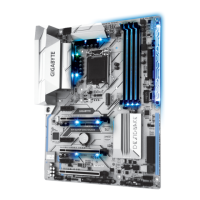
Do you have a question about the Gigabyte GA-Z270X-DESIGNARE and is the answer not in the manual?
| ECC | Yes |
|---|---|
| Memory channels | Hepta-channel |
| Memory slots type | DIMM |
| Number of memory slots | 4 |
| Supported memory types | DDR4-SDRAM |
| Supported memory clock speeds | 2133, 2400, 2666, 2800, 3000, 3200, 3300, 3333, 3400, 3466, 3600, 3666, 3733, 3800, 3866 MHz |
| Supported memory module capacities | 4GB, 8GB, 16GB |
| Processor socket | LGA 1151 (Socket H4) |
| Processor manufacturer | Intel |
| Compatible processor series | Intel Celeron, Intel Pentium |
| Intel® Core i3/i5/i7/i9 series | i3-7xxx, i5-7xxx, i7-7xxx |
| USB 2.0 connectors | 2 |
| Number of SATA connectors | 8 |
| Number of SATA III connectors | 6 |
| Number of Parallel ATA connectors | 0 |
| USB 3.2 Gen 1 (3.1 Gen 1) connectors | 1 |
| BIOS type | UEFI AMI |
| ACPI version | 5.0 |
| BIOS memory size | 128 Mbit |
| USB 2.0 ports quantity | USB 2.0 ports have a data transmission speed of 480 Mbps, and are backwards compatible with USB 1.1 ports. You can connect all kinds of peripheral devices to them. |
| Ethernet interface type | Gigabit Ethernet |
| Component for | PC |
| Motherboard chipset | Intel® Z270 |
| Audio output channels | 7.1 channels |
| Motherboard form factor | ATX |
| Windows operating systems supported | Windows 10 Education, Windows 10 Education x64, Windows 10 Enterprise, Windows 10 Enterprise x64, Windows 10 Home, Windows 10 Home x64, Windows 10 IOT Core, Windows 10 Pro, Windows 10 Pro x64, Windows 7 Enterprise, Windows 7 Enterprise x64, Windows 7 Home Basic, Windows 7 Home Basic x64, Windows 7 Home Premium, Windows 7 Home Premium x64, Windows 7 Professional, Windows 7 Professional x64, Windows 7 Starter, Windows 7 Starter x64, Windows 7 Ultimate, Windows 7 Ultimate x64, Windows 8, Windows 8 Enterprise, Windows 8 Enterprise x64, Windows 8 Pro, Windows 8 Pro x64, Windows 8 x64, Windows 8.1, Windows 8.1 Enterprise, Windows 8.1 Enterprise x64, Windows 8.1 Pro, Windows 8.1 Pro x64, Windows 8.1 x64 |
| RAID levels | 0, 1, 5, 10 |
| Parallel processing technology support | 2-Way CrossFireX, 2-Way SLI, 3-Way CrossFireX |
| PCI Express x1 slots | 3 |
| Depth | 244 mm |
|---|---|
| Width | 305 mm |
General guidelines and safety precautions before installing hardware components.
Detailed specifications of the motherboard's components, including CPU, memory, and slots.
Step-by-step instructions for safely installing the Central Processing Unit (CPU).
Guidance on correctly installing RAM modules into the motherboard's DIMM slots.
Instructions for installing various expansion cards into PCI Express slots.
Steps for setting up AMD CrossFire or NVIDIA SLI configurations.
Description of rear panel I/O ports, including USB, audio, and video outputs.
Overview of internal headers and connectors on the motherboard for various devices.
Details the initial GIGABYTE logo screen upon system startup.
Section for advanced system tuning, overclocking, and voltage adjustments.
Displays system model, BIOS version, and allows setting system date and time.
Settings for boot order, security options, and other essential BIOS configurations.
Options to enable/disable onboard devices like graphics, audio, and USB ports.
Configuration of chipset-specific features like integrated graphics and LAN controller.
Settings controlling system power states, AC BACK, and wake-up events.
Options to save changes, load defaults, or exit the BIOS setup utility.
Guide on setting up RAID arrays using EZ RAID or UEFI RAID features.
Instructions for enabling Intel Optane Technology for storage acceleration.
Steps for installing essential motherboard drivers and software after OS installation.
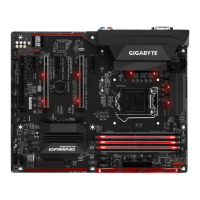
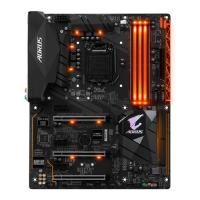
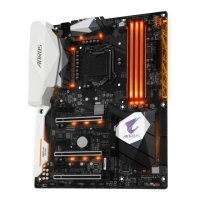
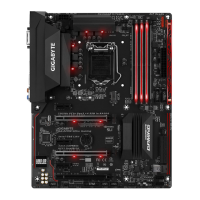
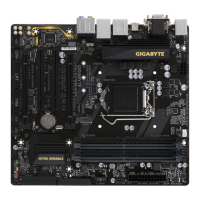
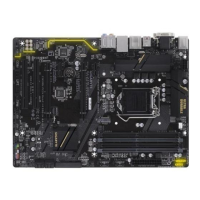
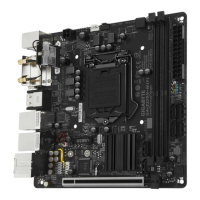

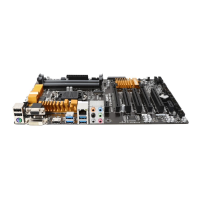
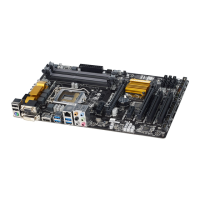
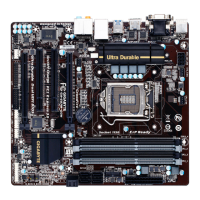
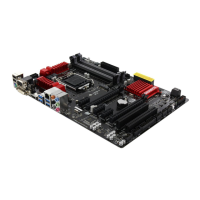
